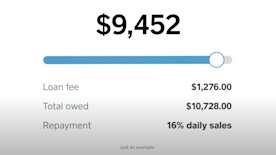Poll a Slack channel full of copywriters about their most-hated jargon, and you’ll get a lively exchange of words like “leverage,” “utilize,” “evergreen,” “align,” “learnings,” and several alphabets’ worth of acronyms.
Jargon, like any other tool, works in the way you wield it. In its narrowest sense, it just means the specialized terms specific to a field, like medicine, law, or finance. It’s a way for a group of people with specialized knowledge to communicate with each other about the complexities of their field.
That’s it’s official purpose. But among its many off-label uses, exclusion might be the most powerful. When you use terms that only insiders understand, you keep everyone else out. Whether exclusion is the intention or not, the result is the same.
When you use terms that only insiders understand, you keep everyone else out.
At Square, economic empowerment is our purpose. We work to open up financial systems and technological access to those who have been excluded from them. Square started with the idea of providing everyone the ability to accept credit cards at a time when many small businesses found the process difficult, if not impossible. We believe this process should be much simpler and transparent, including the language used to describe it.
So jargon runs counter to our purpose. However, Square sits at the intersection of financial services and technology, two industries that regularly top the jargon power rankings. To truly open up access to those industries, we need to expand access to understanding their jargon as well.
That’s why education is a key part of economic empowerment. BOPIS, BORIS, and COGS certainly sound like jargon, but if you’re a retailer of any size, you need to know what they mean. That’s where our Town Square blog comes in, with articles on every aspect of running a business, from how to write a business plan to QR codes and how to use them.
In marketing copy, however, we don’t always have room to explain. Avoid jargon, our style guide tells us, and it’s true—often there’s a simpler way to say something. But sometimes what gets labeled as jargon is actually the correct (or only) term for a concept and the best way to express it. What’s a jargon-averse copywriter to do?
Our rule of thumb is to tailor our language to our audience. Just about every business needs to accept payments, so our primary audience at Square is pretty broad. We want to keep our language as open as possible when we write for this audience, so anyone can understand it. With more specific audiences, like restaurateurs or software developers, we can use more specific language because we want to communicate that we understand their industry and their needs.
Here are a few examples of how we approach jargon in our copy.
Making sense of EMV
When terms like EMV, chip cards, and the liability shift first started circulating in the early 2010s, they weren’t in most people’s vocabularies. But for any business accepting credit cards, they were really important to understand. It didn’t help that EMV (Europay, Mastercard, Visa) is one of those acronyms where spelling it out does nothing to explain it. So we set out to demystify and educate with countless Town Square articles and things like this video, which breaks down all the jargon into plain language, with the added bonus of cute animations:
Extra sauce on the side
When we launched Square for Restaurants, we had to show that we understood the restaurant industry and restaurateurs could trust our software to run their business. In effect, we had to show that we knew the lingo, and restaurant lingo became the recurring motif of the launch campaign.
Omni-what?
Take “omnichannel.” Jargon? Definitely. But it’s not meaningless. Though it shows up in lots of creative briefs and internal discussions, we try to keep it out of marketing copy because there are just better ways to say it: “Sell online and in person.” “Sell in more ways.” “Sell anywhere your customers shop.” (Retailers who might know the term but aren’t sure what it means can find lots of in-depth articles about it on Town Square.)
Clear about credit
Copywriters for Square Capital, which provides access to business loans for Square sellers, know a lot about translating internal and industry jargon into plain language. The role of opaque jargon in the offering of credit has a long and ugly history, so Capital copywriters are especially vigilant about being as clear and transparent in their language as possible. Internally we call the core product a “flex loan” and the repayment percentage the “hold rate,” words that have meaning for us, but in copy, we use “business loan” and “repayment rate,” words that have meaning for everyone.
At Square we try to keep our copy as clear and transparent as our processing rates. But we also want to sound like we know what we’re talking about when we’re talking to specific audiences, which can make some jargon hard to avoid. Keeping our purpose of economic empowerment always front of mind allows us to discern when and where jargon is appropriate.
This article is for educational purposes and does not constitute legal, employment, or tax advice. For specific advice applicable to your business, please contact a professional.





